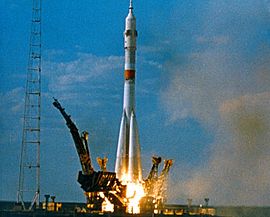A Russian Soyuz U failed earlier today losing three tons of supplies for the International Space Station. But no lives were lost or even at risk:
The unmanned spacecraft, called the Progress, lifted off from the Baikanur Russian Space Center in Kazakhstan on top of a Soyuz rocket. A little more than five minutes later, the rocket’s third-stage engine shut down sooner than it should have, before the Progress had enough velocity to reach orbit.
Had the Progress capsule been manned, odds are very good the crew could have been recovered unharmed after an exciting suborbital abort and parachute assisted landing. One of the huge advantages of traditional booster rockets over the shuttle lays in successful abort. In the rocket configuration, the capsule is at the tippy-top, designed to withstand enormous stress in the direction of motion, and it features a handy heat shield between crew and fuel. Even in the event the rocket explodes on the pad, the escape tower can blow the capsule clear and give the occupants a fighting chance of walking away. But the accident raises questions about the reliability of the aging ex-Soviet design and augers well for newspace companies like SpaceX.
The Falcon 9 is already in developmental testing for cargo and the Dragon capsule was successfully returned from low earth orbit last December (Video here). This rocket and its growing list of competitors could be operational sooner if the schedule was accelerated. It might take a dozen or two cargo launches to tweak and certify the manned capability. If those launches happen over two years instead of five, we have a manned rocket way cheaper than the Russian R-7 family made right here in the US. And to repeat, the biggest change in the works isn’t how much NASA pays private contractors, it’s how those contractors are paid. Newspace flat-fee vs. traditional aerospace cost-plus.
There’s a lot of smart people inside and outside NASA who would like to support our domestic commercial space industry. Unfortunately, there’s an equally powerful group hell-bent on preserving the status quo benefitting traditional aerospace companies and key political districts. Dana Rohrabacher (R-CA 46) sits on the House Science Committee and released a statement (No link available yet)which includes:
“I hope this is a minor problem with a quick and simple fix,” said Rohrabacher. “But this episode underscores America’s need for reliable launch systems of its own to carry cargo and crew into space. The only way to achieve this goal is to place more emphasis on commercial cargo and crew systems currently being developed by American companies. … “We need to get on with the task of building affordable launch systems to meet our nation’s needs for access to low Earth orbit, instead of promoting grandiose concepts which keep us vulnerable in the short and medium terms. The most responsible course of action for the United States is to dramatically accelerate the commercial crew systems already under development.
Rohrabacher goes on to “challenge” NASA Director Charles Bolden to make it happen. A little political grandstanding there, as Bolden serves at the pleasure of the WH which has already been promoting newspace. Even as some of Rohrabacher’s GOP peers, many of whom enjoy NASA dollars in their home states and districts, accuse Obama and newspace of wanting to kill the US space program. It’s a weird issue that defies the usual left-right axis. The best way to understand it isn’t political, it’s the Joe Pesci method from the movie Casino; the dollars, always the fucking dollars.



Leave a Reply
You must be logged in to post a comment.